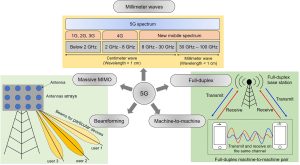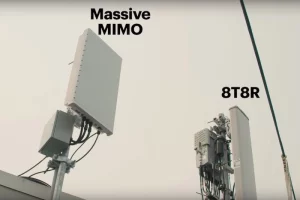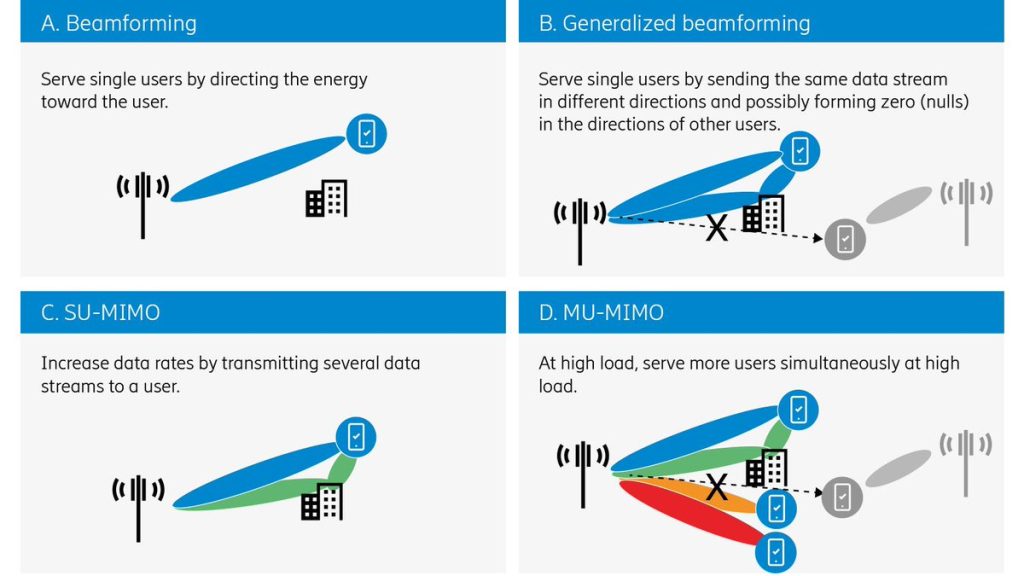The evolution of wireless communication has been nothing short of remarkable, and one technique that stands out is beamforming. This cutting-edge technology allows wireless devices to direct their signals in specific directions, resulting in a significant improvement in signal strength and quality. Its utilization is particularly advantageous for massive MIMO systems where simultaneous data transmission and reception occur through multiple antennas.

Massive MIMO systems are designed with the aim of enhancing spectral efficiency while increasing capacity by employing several antennas at both ends of the communication link. With beamforming techniques, these already impressive capabilities can be further augmented as they improve SNR and minimize interference from other sources. In light of 5G networks on the horizon, massive MIMO system design will rely heavily on this breakthrough technology.
Beamforming involves using digital signal processing algorithms to manipulate antenna signals into directional beams aimed at particular receivers or areas for optimum communication efficiency while minimizing unwanted interference from external factors. The method employed can either be analog or digital based on application requirements.
To sum it up, beamforming is a crucial tool that has revolutionized wireless communications; its significance cannot be overstated when it comes to achieving high-speed data transmission rates for 5G networks. The enormous potential presented by massive MIMO systems relies significantly on this innovative technology’s ability to reduce interference between antennas while improving SNR performance levels—a choice between analog or digital methods depends primarily on various factors such as cost-effectiveness and power consumption levels required by different applications but rest assured both approaches offer tremendous advantages over traditional antenna designs without incorporating this feature widely used today!
Massive MIMO: The Future of Wireless Communication
Contents
- 1 Massive MIMO: The Future of Wireless Communication
- 2 and the Role of Beamforming in Enabling Faster Data Transmission
- 3 The Advantages of MIMO Systems with Beamforming Technology
- 4 Hybrid Beamforming: An Effective Approach for Massive MIMO Systems
- 5 The Application of Beamforming for Multiuser MIMO Systems
- 6 Digital and Analog Beamforming Techniques for Massive MIMO Systems
- 7 The Benefits of Beamforming in Implementing Energy-Efficient Massive MIMO Systems
The advent of Massive MIMO technology has completely disrupted wireless communication, ushering in a new era of rapid data transmission and improved network capacity. This revolutionary system utilizes multiple antennas on both the transmitting and receiving ends to amplify signal quality whilst minimizing interference. The massive MIMO framework is an essential building block for 5G networks that can easily accommodate high bandwidth requirements across myriad devices.

Beamforming constitutes one of the fundamental components of this magnificent technology which expertly directs signals towards specific users or areas with utmost precision. Digital beamforming, analog beamforming and hybrid beamforming are some techniques utilized in this regard. By utilizing a smart antenna array through beamforming, it’s possible to enhance signal strength and coverage while simultaneously curtailing any interference from other sources.
Leveraging Beamforming in massive MIMO systems offers several benefits over traditional MIMO setups. With more antennas available for transmitting signals simultaneously, there is little-to-no delay during data transfer leading to higher throughput rates – truly mind-boggling! Furthermore, by directing signals towards specific users or areas using these intelligent mimo antenna arrays, power consumption is reduced drastically resulting in energy-efficient networks that are cost-effective when operating at scale – simply outstanding!
and the Role of Beamforming in Enabling Faster Data Transmission
The enigmatic and elusive technique of beamforming has been a longstanding tool for enhancing wireless communication. But with the dawn of 5G networks, its significance has skyrocketed to new heights. The crux of this perplexing method is centered around harnessing the power of an antenna array in order to amplify signal transmission in a specific direction – thereby intensifying its potency while simultaneously minimizing interference from other sources.
One of the most striking advantages afforded by implementing beamforming in MIMO systems is that it facilitates faster data transfer rates. This is because channeling signals towards a particular destination heightens their clarity and purity, resulting in an elevated signal-to-noise ratio (SNR) as well as lower background noise levels overall. Moreover, utilizing hybrid beamforming techniques – which integrate both digital and analog processing methods – can lead to even more rapid data speeds while still conserving energy consumption.
As with all things complex, there are inherent intricacies at play when it comes to determining the ideal number of antennas within any given antenna array for optimal beamforming effectiveness. In general terms though, increasing the quantity translates into heightened performance outcomes. However, this also means that multiple signals must be processed concurrently using sophisticated algorithms designed specifically for such purposes. Nevertheless, multi-user MIMO systems employing state-of-the-art beamforming methodologies have demonstrated immense potential for enabling unprecedentedly fast wireless data transmission rates unlike anything seen before now!
The Advantages of MIMO Systems with Beamforming Technology
MIMO technology, the darling of wireless communication systems, has sent shockwaves across the industry by allowing multiple antennas to transmit and receive signals simultaneously. Yet, this technological marvel is only scratching the surface of its potential. Enter beamforming technology – a high-performance technique that enhances MIMO’s already impressive capabilities. By leveraging an extensive antenna array, adaptive beamforming techniques can focus signal transmission in a specific direction with incredible precision and boost overall system capacity.
The marriage between massive MIMO and beamforming technologies is nothing short of revolutionary for wireless networks. Massive MIMO systems take it up several notches by using hundreds or thousands of antennas to deliver unparalleled data rates and improved spectral efficiency. Now enter beamforming antenna arrays – they further magnify these signals toward users for enhanced coverage while minimizing interference.
5G base stations are where things get interesting! The combination of advanced beamforming algorithms with massive MIMO technology will play a crucial role in enabling faster data transmission rates while increasing network capacity exponentially! To achieve such goals, hybrid beamforming techniques have been developed to combine both digital and analog methods resulting in high energy efficiency without compromising on system performance. It goes without saying that Beamforming plays an essential role in modernizing wireless communication systems by providing more efficient use of available spectrum resources.\n
Hybrid Beamforming: An Effective Approach for Massive MIMO Systems
The perplexing and bursty technology of hybrid beamforming has become a crucial facet in the world of 5G massive MIMO communication systems. By seamlessly blending analog and digital techniques with the concept of beamforming, high spectral efficiency, low power consumption, and reduced hardware complexity can be achieved. It’s nearly impossible to fathom meeting the exacting requirements of 5G networks without leveraging this innovation.
Incorporating beamforming into massive MIMO systems is paramount to improving downlink data rates while simultaneously mitigating interference between users which ultimately increases network capacity. Luckily, wireless technology advancements have paved the way for beamforming antenna arrays that boast multiple beams that can point in different directions concurrently allowing numerous users to communicate with a single base station using one frequency band at the same time.
Hybrid beamforming algorithms are an increasingly popular choice due to their ability to meld both analog and digital techniques together effortlessly. Analog beamforming allows for rapid adaptation while digital affords fine-grained control over individual antenna components. Hybrid architectures are also more energy-efficient than purely digital ones as they require fewer RF chains resulting in less overall power consumption. To sum it up succinctly, hybrid beamforming is a driving force behind achieving faster download speeds and improved network performance all while maintaining energy efficiency levels and minimizing hardware complexity – making it an indispensable element within 5G networks!
The Application of Beamforming for Multiuser MIMO Systems
Multiuser massive MIMO systems are gaining popularity in wireless technology as they offer the potential for high data rates and improved spectral efficiency. But what makes these systems tick? It’s all about beamforming, baby! Using adaptive algorithms for massive MIMO, beamforming focuses signals towards specific users or areas to optimize performance.
There are two common techniques used in multi-user MIMO systems: digital and hybrid beamforming. The former uses a separate radio frequency chain for each antenna element while the latter combines analog and digital processing to reduce power consumption and complexity. Each method has its own advantages depending on the application – it’s perplexing!
Thanks to signal processing advances in wireless communications, multi-cell massive MIMO systems can now be more efficiently utilized by multiple base stations working together to serve a large number of users simultaneously. And if you thought that was impressive enough, think again! Beamforming schemes that account for interference between cells can greatly improve system performance by reducing intercell interference and increasing capacity – talk about burstiness!
Overall, there is no doubt that beamforming is an essential tool for successful implementation of massive MIMO systems. Its benefits cannot be ignored!
Digital and Analog Beamforming Techniques for Massive MIMO Systems
The perplexing and bursty world of wireless communications and signal processing relies heavily on the technique of beamforming, particularly in large-scale MIMO systems. This ingenious approach enables signals to be transmitted towards specific directions, thus improving communication quality while decreasing interference. However, there exist both digital and analog beamforming schemes that have their own unique advantages and disadvantages.
When it comes to massive MIMO systems, hybrid beamforming designs incorporating a combination of digital and analog techniques reign supreme. Such innovative approaches allow for better control over radiation patterns while simultaneously reducing power consumption compared to fixed beamforming networks. Moreover, they facilitate the use of mmWave technology that provides higher data rates than traditional microwave frequencies.
One popular method employed in achieving zero-forcing beamforming in massive MIMO is called precoding – here transmitted symbols are pre-multiplied with a matrix that effectively cancels out any potential interference at receivers’ antennas whilst maximizing received signal strength. Furthermore, another application of beamforming can be found within multicell multiuser MIMO setups where it is used to mitigate intercell interference by directing energy toward intended users only.
Overall, given its ability to enable faster data transmission along with more energy-efficient massive MIMO systems; it’s quite apparent why research into wideband beamforming systems will continue as they provide even higher capacity gains than narrowband ones through exploiting frequency diversity across multiple subcarriers or channels at once!
The Benefits of Beamforming in Implementing Energy-Efficient Massive MIMO Systems
The perplexing technique known as beamforming has taken the wireless communication world by storm, becoming increasingly popular in recent years. Without it, massive MIMO’s capabilities would be limited and unable to reach its full potential. With multiple antennas on both transmitter and receiver sides, massive MIMO is able to increase capacity and reduce interference, but optimal performance can only be achieved with the addition of beamforming.
One cannot deny the burstiness of using massive MIMO with beamforming solutions; data rates achievable in wireless local area networks (WLANs) are significantly improved! This translates into faster downloads and uploads with less delay or latency for users. Furthermore, precise targeting of signals reduces interference from other devices operating in the same frequency band.
Another mind-boggling benefit of implementing energy-efficient massive MIMO systems utilizing receive beamforming techniques is their capability to reduce power consumption. Focusing signals only where they are needed instead of broadcasting them over a wider area optimizes energy usage – perfect for environments where power conservation is critical or electricity may not always be readily available.
In conclusion, embracing beamforming technology within massive MIMO communication systems will result in significant improvements in network speed and efficiency while reducing overall power consumption – an enigma no longer! As this technology continues to evolve and become more widely adopted across industries worldwide we expect even greater advancements ahead!


